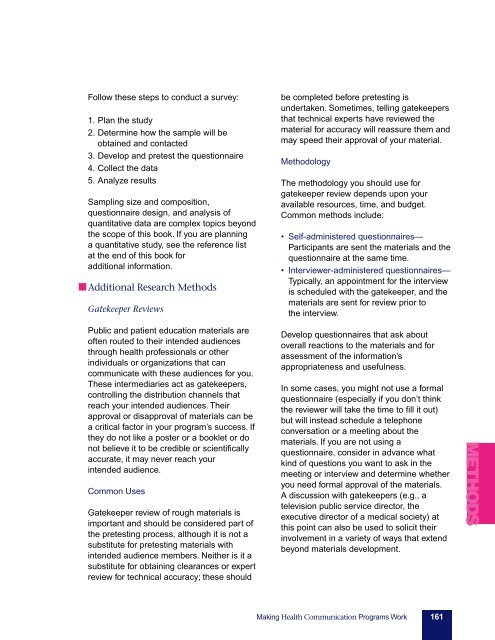pink-book
pink-book
pink-book
You also want an ePaper? Increase the reach of your titles
YUMPU automatically turns print PDFs into web optimized ePapers that Google loves.
Follow these steps to conduct a survey:<br />
1. Plan the study<br />
2. Determine how the sample will be<br />
obtained and contacted<br />
3. Develop and pretest the questionnaire<br />
4. Collect the data<br />
5. Analyze results<br />
Sampling size and composition,<br />
questionnaire design, and analysis of<br />
quantitative data are complex topics beyond<br />
the scope of this <strong>book</strong>. If you are planning<br />
a quantitative study, see the reference list<br />
at the end of this <strong>book</strong> for<br />
additional information.<br />
Additional Research Methods<br />
Gatekeeper Reviews<br />
Public and patient education materials are<br />
often routed to their intended audiences<br />
through health professionals or other<br />
individuals or organizations that can<br />
communicate with these audiences for you.<br />
These intermediaries act as gatekeepers,<br />
controlling the distribution channels that<br />
reach your intended audiences. Their<br />
approval or disapproval of materials can be<br />
a critical factor in your program’s success. If<br />
they do not like a poster or a <strong>book</strong>let or do<br />
not believe it to be credible or scientifically<br />
accurate, it may never reach your<br />
intended audience.<br />
Common Uses<br />
Gatekeeper review of rough materials is<br />
important and should be considered part of<br />
the pretesting process, although it is not a<br />
substitute for pretesting materials with<br />
intended audience members. Neither is it a<br />
substitute for obtaining clearances or expert<br />
review for technical accuracy; these should<br />
be completed before pretesting is<br />
undertaken. Sometimes, telling gatekeepers<br />
that technical experts have reviewed the<br />
material for accuracy will reassure them and<br />
may speed their approval of your material.<br />
Methodology<br />
The methodology you should use for<br />
gatekeeper review depends upon your<br />
available resources, time, and budget.<br />
Common methods include:<br />
• Self-administered questionnaires—<br />
Participants are sent the materials and the<br />
questionnaire at the same time.<br />
• Interviewer-administered questionnaires—<br />
Typically, an appointment for the interview<br />
is scheduled with the gatekeeper, and the<br />
materials are sent for review prior to<br />
the interview.<br />
Develop questionnaires that ask about<br />
overall reactions to the materials and for<br />
assessment of the information’s<br />
appropriateness and usefulness.<br />
In some cases, you might not use a formal<br />
questionnaire (especially if you don’t think<br />
the reviewer will take the time to fill it out)<br />
but will instead schedule a telephone<br />
conversation or a meeting about the<br />
materials. If you are not using a<br />
questionnaire, consider in advance what<br />
kind of questions you want to ask in the<br />
meeting or interview and determine whether<br />
you need formal approval of the materials.<br />
A discussion with gatekeepers (e.g., a<br />
television public service director, the<br />
executive director of a medical society) at<br />
this point can also be used to solicit their<br />
involvement in a variety of ways that extend<br />
beyond materials development.<br />
METHODS<br />
Making Health Communication Programs Work 161


